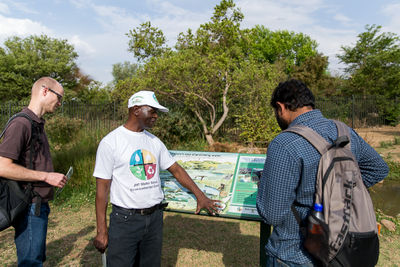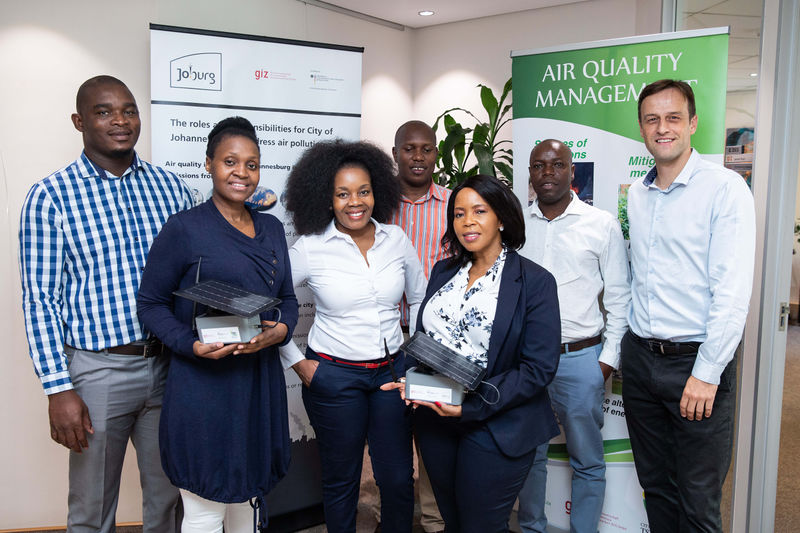Difference between revisions of "South African Air Quality Management - A Tale of Two Cities"
***** (***** | *****) (Created page with " South African Air Quality Management - A Tale of Two Cities <br/> Overview <span lang="EN-US" style="margin: 0px;"><font face="Calibri" size="2">The City of Tshwane (CoT) ...") |
***** (***** | *****) m |
||
| (4 intermediate revisions by 2 users not shown) | |||
| Line 1: | Line 1: | ||
| − | South | + | = '''Overview''' = |
| + | |||
| + | [[File:AQM GIZ South Africa JNF Walter Sisulu Environmental Center in Mamelodi, City of Tshwane WSEC -0870.jpg|right|400pxpx|The JNF Walter Sisulu Environmental Center in Mamelodi, City of Tshwane, educates visitors about environmental issues in their community. 2020|alt=The JNF Walter Sisulu Environmental Center in Mamelodi, City of Tshwane, educates visitors about environmental issues in their community. 2020]]<span style="margin: 0px" lang="EN-US"><font size="2" face="Calibri">The City of Tshwane (CoT) and the City of Johannesburg (CoJ) in [[South Africa Energy Situation|South Africa]] comprise most of the population of Gauteng, the most densely populated Province in South Africa, which is home to 25.8% of the country’s population. Gauteng is also the economic hub of the country. As such, air quality in these two cities has far reaching impacts on public health and the national economy. The GIZ has been assisting the CoT and CoJ administration with their air quality management activities as part of the BMU-funded Integrated Air Quality Management and Climate Change Mitigation project.</font></span> | ||
<br/> | <br/> | ||
| − | + | = '''Two cities, both alike in air quality''' = | |
| − | <span lang="EN-US | + | <span style="margin: 0px" lang="EN-US"><font size="2" face="Calibri">The CoT and the CoJ have similar sources of pollutants, ranging from emissions from near-by power plants, residential fuel burning, motor vehicles to industrial and manufacturing sources. The cities manage air quality through the implementation of air quality management plans (AQMP) and other tools such as by-laws that require partnerships with other departments, such as planning and energy and external stakeholders like GIZ.</font></span> |
| − | < | + | <span style="margin: 0px" lang="EN-US"><font size="2" face="Calibri">Both cities recently reviewed and updated their AQMPs, and some commonalities emerged. Some of them are listed below:</font></span> |
| + | |||
| + | #<span style="margin: 0px" lang="EN-US"><span style="margin: 0px"><span></span></span></span><font size="2"><font face="Calibri"><span style="margin: 0px" lang="EN-US">Ambient monitoring data: It is difficult to assess whether there have been any long-term trends in the data, because of a lack of data availability and variable data quality. To fill the air quality data gap that plagues the continent, both cities have recently deployed – in addition to regulatory monitors – low-cost sensors. The next step is to make the respective data freely available on the </span><span style="margin: 0px" lang="EN-ZA">[http://saaqis.environment.gov.za/ SAAQIS]</span><span style="margin: 0px" lang="EN-US">website.</span></font></font> | ||
| + | #<span style="margin: 0px" lang="EN-US"><span style="margin: 0px"><span></span></span></span><span style="margin: 0px" lang="EN-US"><font size="2" face="Calibri">Trans-boundary air pollution: Both cities are impacted by pollution emitted outside their respective city limits.</font></span> | ||
| + | #<span style="margin: 0px" lang="EN-US"><span style="margin: 0px"><span></span></span></span><span style="margin: 0px" lang="EN-US"><font size="2" face="Calibri">Residential burning and vehicle emissions have emerged as sources of local concern, which marks a shift from industrial emissions as the major focus of emission reduction strategies.</font></span> | ||
| + | |||
| + | <span style="margin: 0px" lang="EN-US"><font size="2" face="Calibri">To ensure that both cities can adequately combat air pollution, examining those commonalities and differences in urban areas is of vital importance.</font></span> | ||
| − | + | [[File:AQM GIZ South Africa 2020 Emission sensors Übergabe Clarity 01.jpg|right|800pxpx|Handing over new solar-powered low-cost emission sensors to city officials of the City of Johannesburg, 2020|alt=Handing over new solar-powered low-cost emission sensors to city officials of the City of Johannesburg, 2020]]<br/> | |
| − | + | = '''Further Information''' = | |
| − | <span lang="EN-US" style="margin: 0px | + | *<span style="margin: 0px" lang="EN-ZA">[https://www.international-climate-initiative.com/en/details/project/integrated-air-quality-management-aqm-and-climate-change-mitigation-in-the-framework-of-the-world-banks-pollution-management-and-environmental-health-pmeh-programme-17_I_355-2865 Integrated Air Quality Management (AQM) and Climate Change Mitigation in the framework of the World Bank’s Pollution Management and Environmental Health (PMEH) Programme]</span><span style="margin: 0px" lang="EN-US"></span> |
| + | *<span style="margin: 0px" lang="EN-ZA"></span><span style="margin: 0px" lang="EN-US"></span><span style="margin: 0px" lang="EN-ZA">[https://www.dw.com/en/breathing-easy-hanoi-attempts-to-improve-its-air-quality/a-45826152 https://www.dw.com/en/breathing-easy-hanoi-attempts-to-improve-its-air-quality/a-45826152]</span><span style="margin: 0px"><span style="margin: 0px" lang="EN-US"></span></span> | ||
| + | *<span style="margin: 0px" lang="EN-ZA">[http://saaqis.environment.gov.za/ http://saaqis.environment.gov.za/]</span><span style="margin: 0px" lang="EN-US"></span> | ||
| + | *All articles of the category "[[:Category:Air Quality Management|Air Quality Management]]" | ||
| − | < | + | <br/> |
| − | + | = '''References''' = | |
| − | <span | + | *<span style="margin: 0px" lang="EN-US"><font size="2" face="Calibri">City of Tshwane (2019) Air Quality Management Plan</font></span> |
| + | *<span style="margin: 0px; font-family: Symbol" lang="EN-US"><span style="margin: 0px"><span></span></span></span><span style="margin: 0px" lang="EN-US"><font size="2" face="Calibri">City of Johannesburg (2019) Draft Air Quality Management Plan</font></span> | ||
| − | + | [[Category:Air_Quality_Management]] | |
Latest revision as of 11:13, 19 August 2020
Overview
The City of Tshwane (CoT) and the City of Johannesburg (CoJ) in South Africa comprise most of the population of Gauteng, the most densely populated Province in South Africa, which is home to 25.8% of the country’s population. Gauteng is also the economic hub of the country. As such, air quality in these two cities has far reaching impacts on public health and the national economy. The GIZ has been assisting the CoT and CoJ administration with their air quality management activities as part of the BMU-funded Integrated Air Quality Management and Climate Change Mitigation project.
Two cities, both alike in air quality
The CoT and the CoJ have similar sources of pollutants, ranging from emissions from near-by power plants, residential fuel burning, motor vehicles to industrial and manufacturing sources. The cities manage air quality through the implementation of air quality management plans (AQMP) and other tools such as by-laws that require partnerships with other departments, such as planning and energy and external stakeholders like GIZ.
Both cities recently reviewed and updated their AQMPs, and some commonalities emerged. Some of them are listed below:
- Ambient monitoring data: It is difficult to assess whether there have been any long-term trends in the data, because of a lack of data availability and variable data quality. To fill the air quality data gap that plagues the continent, both cities have recently deployed – in addition to regulatory monitors – low-cost sensors. The next step is to make the respective data freely available on the SAAQISwebsite.
- Trans-boundary air pollution: Both cities are impacted by pollution emitted outside their respective city limits.
- Residential burning and vehicle emissions have emerged as sources of local concern, which marks a shift from industrial emissions as the major focus of emission reduction strategies.
To ensure that both cities can adequately combat air pollution, examining those commonalities and differences in urban areas is of vital importance.
Further Information
- Integrated Air Quality Management (AQM) and Climate Change Mitigation in the framework of the World Bank’s Pollution Management and Environmental Health (PMEH) Programme
- https://www.dw.com/en/breathing-easy-hanoi-attempts-to-improve-its-air-quality/a-45826152
- http://saaqis.environment.gov.za/
- All articles of the category "Air Quality Management"
References
- City of Tshwane (2019) Air Quality Management Plan
- City of Johannesburg (2019) Draft Air Quality Management Plan





















